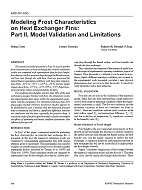The numerical model presented in Part I is used to predictfrost characteristics on heat exchanger fins, and the simulationresults are compared with experimental data for frost height,frost density, airflow pressure drop through the finned section,and heat rate through the cold base. Data are presented fortypical freezer operating conditions with base plate temperaturesfrom -31°C to -38°C (-24°F to -36°F) and air supplytemperatures from -13°C to -21°C (8°F to -5°F). Experimentaluncertainty values are presented for all data.For moderate frost heights and less than 50% of the heatexchanger passages blocked with frost, the simulation resultsand experimental data agree within the experimental uncertaintywith few exceptions. For thick frost and more than 50%of passages blocked with frost, the frost on the fins appears tobe distributed in such a manner that the measured pressuredrop is minimized and there is significant difference betweenthe simulation and the data, especially for pressure drop. Asensitivity study of the frost growth model is used to investigatethe effects of operating and initial condition parameters thatinfluence frost growth.
Also paper MN-00-6-2, in MN-00-6, Symposium on Advances in Thermal and Fluid Fow Charateristics of HVAC and Refrigeration Processes
Units: Dual
Citation: ASHRAE Transactions, vol. 106, pt. 2
Product Details
- Published:
- 2000
- Number of Pages:
- 9
- File Size:
- 1 file , 290 KB
- Product Code(s):
- D-7258
